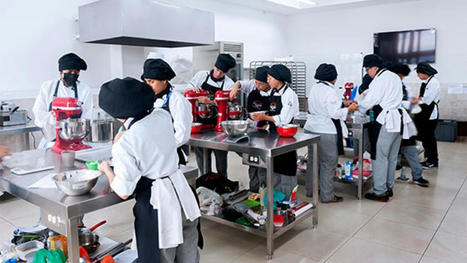According to the National Institute of Statistics and Census (INEC), in Ecuador, 26 percent of women and 11 percent of men between the ages of 15 and 24 are neither working nor in school (the so-called “NiNis”).
Nineteen-year-old Diana Tates, who graduated from high school in 2020, is a “NiNi.” When the economic crisis triggered by the pandemic hit, she had to drop out of university because she could not afford the tuition fees. She decided instead to take care of her younger siblings because she believed that she would not be able to get a job without a degree.
For young people like Diana, technical education offers a powerful educational alternative, because they can acquire practical knowledge in a short time and have easier access to the labor market, thus paving the way for the development of a high-quality labor force in the region.
A World Bank report has shown that academic and labor market outcomes of short-cycle programs help generate employment and develop skilled human capital to meet the demand for these skills in a short amount of time and at a lower cost per student.
Three advantages of technical institutes:
Their students graduate at higher rates than students in university degree programs
Their graduates earn more than persons who only have a high school diploma or who have not completed a university degree.
The unemployment rate is lower among their graduates.
In this context, technical degree programs, which typically last two or three years and are oriented to the labor market, could be extremely helpful in generating employment by offering a path to fairly quick, well-paying job opportunities.
Are short-cycle programs a solution to the crisis?
Given the potential of technical and technological careers, there is an urgent need to provide young people with access to high-quality, short-cycle education programs. To that end, in 2016, the Ministry of Higher Education, Science, Technology, and Innovation (SENESCYT) and the World Bank launched a US$52 million project to improve the infrastructure of public technical and technological institutes and enhance the importance of their programs for the productive sector.
The project provided infrastructure and equipment for four technical and technology institutes and enhanced the quality of their academic programs. One of the project’s activities was the construction in the city of Machala of the Instituto Tecnológico Ismael Pérez Pazmiño, a technology institute that can accommodate over 2,800 students. The institute is the most modern in the country, with 18 laboratories, two workshops, 32 classrooms, and a library, and is staffed by 130 faculty who provide instruction in more than 10 technical degree programs.
Like the students in Machala, the students at the Yavirak Institute in Quito are also undergoing an educational transformation. The rehabilitation of the institute’s infrastructure, which included the construction and equipping of a building for the Ecuadorean culinary arts program, led to a 90 percent increase in enrollment.
For Adrián Calle, a student, this has been a game changer:
“In my first semester, we were in a classroom that was not a kitchen: it was an office with a bathroom and there was no refrigeration for food ... But now we are in the new workshops where we can innovate, modifying or preserving traditional Ecuadorean flavors... I feel lucky to have had the opportunity to study in these facilities.”
A mix of new and renovated institutes
The project also financed the renovation of the Instituto Tecnológico Luis Arboleda Martínez in the port city of Manta. With a view to improving the quality of education, we worked closely with the private sector to align educational curricula so that they can better meet the demand for technical skills and discuss the equipment needed to develop those skills that will help strengthen port operations.
In the area of quality, the project included activities such as the implementation of a computer-assisted mathematics remediation program, access to the internet in all institutes in the country, testing of cross-cutting skills for students and teachers, the development of an Integrated Academic Management System, and the rollout of virtual reality laboratories in six institutes in the areas of engine repair and industrial risks.
The educational transformation spurred by these initiatives must be sustainable over the long term. To that end, the ongoing coordination work between the productive sector and the technical institutes, and the leadership work being done by the directors of these institutes will be essential to ensure that institutional management practices will translate into improved learning in the classroom. The commitment of the government, the institute, and the student community to maintain the infrastructure and equipment will be fundamental to ensure sustainability.
Ultimately, the quality of the teachers and a focus on their continuing education will ensure that students acquire the skills they need to contribute to local economies. This will provide the foundation for a structural change, not only of the education system but also, in the dynamics of social mobility of the most disadvantaged youth.
No comment yet.
Sign up to comment



 Your new post is loading...
Your new post is loading...







